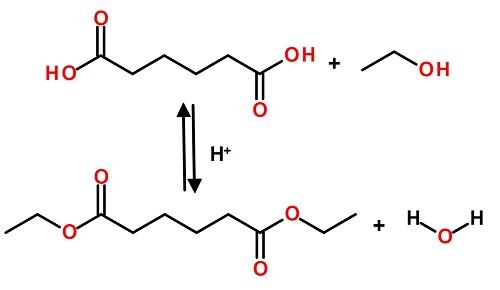| Identification | More | [Name]
Dimethyl adipate | [CAS]
627-93-0 | [Synonyms]
ADIPIC ACID BIS-METHYL ESTER
ADIPIC ACID DIMETHYL ESTER
AKOS BBS-00004546
DBE 6 DIBASIC ESTER
DIMETHYL ADIPATE
DIMETHYL BUTANE-1,4-DICARBOXYLATE
DIMETHYL HEXANEDIOATE
HEXANEDIOIC ACID-DIMETHYL ESTER
1,6-Dimethylhexanedioate
dbe-6
dbe-6dibasicester(dimethyl
dbe-6dibasicester(dimethyladipate)
Dimethyl ester of hexanedioic acid
Dimethylhexaneo-lionate
hexadioic acid, dimethyl ester
Dimethyl hexanedionate
DIMETHYL ADIPATE, 99+%
Dimethyl Adipate-13C6
DIBASICESTERS
Dimethyladipat | [EINECS(EC#)]
211-020-6 | [Molecular Formula]
C8H14O4 | [MDL Number]
MFCD00008469 | [Molecular Weight]
174.19 | [MOL File]
627-93-0.mol |
| Chemical Properties | Back Directory | [Description]
Dimethyl adipate (DMA) is a colourless and flammable liquid. It is soluble in alcohol and
ether but sparingly soluble in water. DMA is incompatible with strong oxidising agents,
and on decomposition, it emits carbon monoxide, irritating and toxic fumes and gases,
and carbon dioxide. DMA reacts with acids, alkalis, and strong oxidants. DMA is synthesised
by the esterification of adipic acid. DMA is part of a dibasic ester (DBE) blend
used as a major ingredient in several paint strippers, and the DBE blends used in paint
stripping formulations contain a major portion (about 90%) of DMA. DMA is used as
a chemical intermediate (polymers, agrochemicals), cellulose resins, a speciality solvent
(inks, coatings, adhesives), and an emollient and can also be utilised as a paint remover
and plasticiser. | [Appearance]
colourless liquid | [Melting point ]
8 °C (lit.) | [Boiling point ]
109-110 °C/14 mmHg (lit.) | [density ]
1.062 g/mL at 20 °C(lit.)
| [vapor pressure ]
0.2 mm Hg ( 20 °C)
| [FEMA ]
4472 | DIMETHYL ADIPATE | [refractive index ]
n20/D 1.428(lit.)
| [Fp ]
225 °F
| [storage temp. ]
Store below +30°C. | [solubility ]
<1g/l | [form ]
Liquid | [color ]
Clear | [Odor]
at 100.00 %. mild nutty | [Stability:]
Stable. Combustible. Incompatible with strong oxidizing agents, acids, bases reducing agents. | [explosive limit]
0.81-8.1%(V) | [Odor Type]
nutty | [Water Solubility ]
Miscible with alcohols and ether. Immiscible with water. | [JECFA Number]
1964 | [Merck ]
14,162 | [BRN ]
1707443 | [InChIKey]
UDSFAEKRVUSQDD-UHFFFAOYSA-N | [LogP]
1.4 at 22℃ | [CAS DataBase Reference]
627-93-0(CAS DataBase Reference) | [NIST Chemistry Reference]
Hexanedioic acid, dimethyl ester(627-93-0) | [EPA Substance Registry System]
627-93-0(EPA Substance) |
| Hazard Information | Back Directory | [Chemical Properties]
Dimethyl adipate (DMA) is a colorless and flammable liquid. It is soluble in alcohol and
ether, but sparingly soluble in water. It reacts with acids, alkalis, and strong oxidants.
Dimethyl adipate is synthesized by the esterifi cation of adipic acid. Dimethyl adipate is
part of a dibasic ester (DBE) blend used as a major ingredient in several paint strippers;
the DBE blends used in paint stripping formulations contain a major portion (about 90%)
of DMA. Dimethyl adipate is used as a chemical intermediate and as a plasticizer in the
production of paper and cellulose resins. | [General Description]
Colorless liquid. | [Reactivity Profile]
DIMETHYL ADIPATE(627-93-0) is an ester. Esters react with acids to liberate heat along with alcohols and acids. Strong oxidizing acids may cause a vigorous reaction that is sufficiently exothermic to ignite the reaction products. Heat is also generated by the interaction of esters with caustic solutions. Flammable hydrogen is generated by mixing esters with alkali metals and hydrides. | [Air & Water Reactions]
Flammable. Hydrolyzed by strong mineral acids and strong alkalis. | [Health Hazard]
Exposures to dimethyl adipate cause toxicity and adverse health effects in laboratory
animals and humans. Workplace exposures to dimethyl adipate by inhalation, ingestion,
or skin absorption cause harmful and irritation effects to users. | [Health Hazard]
May be harmful by inhalation, ingestion, or skin absorption. May cause irritation. | [Uses]
Dimethyl adipate is used in cosmetics (in emollients and skin conditioning).It is used as a plasticizer for cellulose-type resins and a finish remover.It is also used in agrochemicals and dye as well as a precursor for the preparation of active pharmaceutical ingredients. Further, it serves as a polymer intermediate. In addition to this, it is employed as a solvent for paint stripping and resins. | [Definition]
ChEBI: Dimethyl adipate is a fatty acid methyl ester. | [Production Methods]
Dimethyl adipate is manufactured via esterification of adipic
acid and methanol in the presence of an acid catalyst. | [Flammability and Explosibility]
Nonflammable | [Synthesis]
Dimethyl adipate was synthesized by immobilized Candida antarctica lipase B-catalyzed esterification of adipic acid and methanol.

According to the general procedure described above, Dimethyl adipate has been synthesized from adipic acid (730mg, 5 mmol) and methanol (10 ml). Yield: 9%.
1H NMR (400.1 MHz, CDCl3): δ = 3.56 (6H, s, H1-H10), 2.23 (4H, m, H4-H7), 1.56 (4H, m, H5-H6).
13C NMR (100.5 MHz, CDCl3): δ = 173.4 (C3-C8), 51.2 (C1-C10), 33.4 (C4-C7), 24.1 (C5-C6)
https://pubmed.ncbi.nlm.nih.gov/20632329/ | [Carcinogenicity]
In a chronic inhalation toxicity
study of dimethyl adipate, groups of male and female rats
were exposed to 400 mg/m3 of dimethyl adipate over a
90-day period. Focal respiratory metaplasia of the olfactory
epithelium was found. These nonneoplastic lesions were
minimal to mild in severity . | [Toxics Screening Level]
The ITSL for Dimethyl Adipate is 1 μg/m3 based on annual averaging time. |
| Safety Data | Back Directory | [Safety Statements ]
S24/25:Avoid contact with skin and eyes . | [WGK Germany ]
1
| [RTECS ]
AV1645000
| [Autoignition Temperature]
680 °F | [TSCA ]
Yes | [HS Code ]
29171290 | [Precautions]
During handling of dimethyl adipate, occupational workers should be careful and use
self-contained breathing apparatus, rubber boots, and heavy rubber gloves and avoid prolonged
period of exposures. Workers should avoid contact of dimethyl adipate with skin,
eyes and nose. | [Safety Profile]
Moderately toxic by
intraperitoneal route. Experimental
teratogenic and reproductive effects. When
heated to decomposition it emits acrid
smoke and irritating fumes. | [Hazardous Substances Data]
627-93-0(Hazardous Substances Data) | [Toxicity]
LD50 orally in Rabbit: 8191 mg/kg LD50 dermal Rabbit > 2250 mg/kg |
|
|